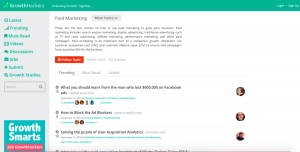If you are like everyone else, you start your day with an inbox full of emails that need to be addressed, phone calls that need to be returned, and meetings that you must attend. We generally live in a reactive world filled with reactive activities that demand our attention. If you really think about it, it is actually human nature to be reactive.
So how do you retrain yourself to think differently? How do you make that investment in moving yourself from a constant reactive state to a world of productivity?
The magical word is “proactive.” You want to move towards proactive customer success, proactive insights on adoption, and proactively anticipating customers’ future needs.
But how do you really know if you are being proactive? How often do you sit down and think about what “proactive” means in the context of your world? How do you cross over to that world, but still keep up with all of the reactive tasks that need your attention?
Very simply put, you need to shift your mental framework and start looking at things through a different lens.
The definition of proactive, per Google, is: “creating or controlling a situation by causing something to happen rather than responding to it after it has happened.” I’d like to note, being reactive isn’t necessarily a bad thing, and is definitely necessary in many situations. But being proactive is by no doubt a less stressful state to operate in.
Think of every reactive moment as a learning opportunity, an opportunity to solve for the future, an opportunity to cause things to happen rather than let them happen. When you encounter these reactive moments, think through the following questions:
- How do I build a better customer experience?
- How can I build a better business?
- How do I focus on desired outcomes rather than activities or busy work?
Always be looking for moments where you can take today’s reactive problem and turn it into tomorrow’s proactive moment.
Proactively Building a better Customer Experience
During all interactions you have – whether with your customer or your team –always be thinking, “How do I build a better customer experience”?
A few easy areas to start implementing this framework are:
- Customer Contacts. Why are your customers contacting you and Support? How can you eliminate the concerns they are reaching out about? Really drill into the core of the issue that is driving the customer’s contact and strive to eliminate that friction.
- Customer Sentiment. Most sentiment scores are lagging indicators. However, I believe that any lagging indicator can provide you with leading insight. Net Promoter Score, Customer Satisfaction, Customer Experience Score are all generally lagging indicators. But, the information you learn from these surveys can go far in understanding and impacting overall customer sentiment and provide action items to improve and drive towards a desired outcome.
- Product Features: As an organization, if you are building features that the customers are not using, then you are technically failing on many levels. You have to build products and features that the customer will not only want and use, but relish. Regularly talk to customers from every customer segment about what features they find the most useful or drive the most impact.
- Scaling your teams and organization: As you grow and scale, there will come a point in time when you do not know everyone’s name (if you are not already there). It’s a weird moment for the early employees in a startup, but if this happens, it generally means you are growing (not a bad thing). How do you make sure that this growth is great for the customer experience and does not degrade it? How can you keep everyone in touch with the customer at every level? Think through communication strategies and customer programs that you can put in place to ensure that everyone is “in the know” on the customer front. A few things you can start now are:
- Share customer feedback trends early and often (good and bad).
- Have customers talk to your team. Humanize your customers across the organization.
- Post-mortem any major customer issues. Come up with a plan on how to mitigate whatever reactive issue occurred. Share your findings with the company (even if the issue started with you).
- Share customer feedback trends early and often (good and bad).
Proactively Building a Better Business
As you go about your day doing your usual reactive tasks, ask yourself “How can I do business better”? Make all of your decisions as if you were the owner of the company. Pretend that all of the money that you deal with on a daily basis is yours (this is assuming you are really great with your own money).
A few tactics that’ll help you start being better at business are:
- Start with the metrics: If you are not tracking key metrics for your customer base and organization, then you are operating blindly. Look at measurements that matter to the entire business on a regular cadence. Churn, LTV, Product Usage, Retention, Upsell are just a few things to look at. I am sure there are more that could be added to this list. Don’t just look at these metrics, understand what they mean and how you can impact them. Get proactive!
- Get control of your levers: I am sure you’ve heard of Sales and Marketing having levers. Customer Success has levers too. It’s important that you have an understanding of what levers you have that impact your goals. For example, how do you increase customer engagement? How do you improve time to first value for various segments? What parts of your product drive the most upsells? These are all examples of levers that you can have direct control over.
- Always have efficiency goals: A large part of moving away from being constantly reactive is becoming more efficient in what you do on a day-to-day basis. When your product is running as efficiently and optimally as possible, your customer base tends to be happier. The same is true for both the Success and Service organizations. I will parrot what I said earlier, look at why your customers are contacting you, and create goals to reduce the contacts in those categories. And again, get proactive!
- Create processes when necessary: Part of building a better business (which hopefully will result in a better customer experience), is making sure you are setting up the right processes to scale and have a sense of predictability around certain tasks that may need to be done. At this point, you may be asking yourself “What does this have to do with getting to proactive?” or “This feels awfully reactive to me…” And the short answer is: you’re right. But putting in the right amount of process at the right time will actually prevent a lot of headache down the line. I think the saying goes “an ounce of prevention is worth a pound of cure.” Well, a proactive standard operating procedure will go a long way in preventing those reactive moments. Just don’t forget to iterate on your processes as your business grows, scales, and evolves.
Proactively Focusing on Outcomes
If you really think about why any service organization is around, it’s typically to compensate or solve for something that is not intuitive in your product. Think about it. From a support standpoint, what are the reasons customers are reaching out? It’s most likely for things that the customer would “self-serve” on if your product made it super simple (billing info, change email, passwords, how to complete something with a certain feature). Customers do not want to have to reach out for help, they want to be successful in the products that they purchase. That is their desired outcome.
Activities, busy work, or whatever you want to call it, generally focuses on the “in the moment” needs. Building upon how to create a better customer experience and business, the next logical step in crossing over to proactive thinking is to start operating in terms of outcomes.
A couple of things that you should immediately look at:
Customer Interactions. Most customer interactions are activity or output-focused (even if you initiate them). For example, think about the following activities:
– Onboarding
– Training
– QBR’s
– Playbooks
– Upselling
These are all prime examples of activities that you do or outputs that require manual intervention. What are your end goals or desired outcomes when you are completing these activities? Increased adoption of your product, training on all of the features, proving ROI and value of your product. If you think through the above-mentioned activities and what outcomes you desire, it becomes more apparent these activities are merely busy work to prove the value of your product. Think proactively.
Meetings: Open up your calendar. Go ahead, I’ll wait. Okay, now… how many of these meetings are focusing on desired outcomes, strategy, or being proactive? And how many are playing the proverbial game of whack-a-mole? A meeting to solve a problem, just to move on to the next meeting to solve a problem?
Unfortunately, you can’t get out of all of these meetings, but is there a better way? I challenge you to think proactively about your meetings and the problems that you are solving. There may be a larger upfront investment to permanently solve these issues (which in a time and resource constrained environment may seem impossible), but making that investment will pay off in dividends down the road.
Business & Finance Articles on Business 2 Community
(66)








